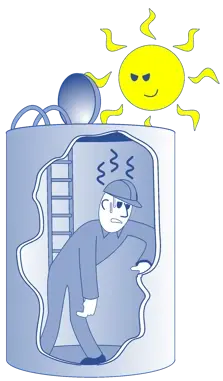However, the Workplace (Health, Safety and Welfare) Regulations 1992 require that workplace temperatures must be “reasonable” during working hours.
For indoor workplaces, the Health and Safety Executive (HSE) recommends at least 16°C for normal work and 13°C if the work involves rigorous physical effort.
There is no upper legal limit, but employers must manage risks in extreme temperatures, especially during a heatwave.
What is a “reasonable” workplace temperature?
A reasonable temperature depends on your work activity and environment.
Office working temperatures are generally comfortable between 18°C and 24°C.
In manufacturing processes, food storage, or outdoor work, temperatures may naturally be much lower or higher.
Employers must provide heating or cooling, ventilation, and protective measures so that employees can work safely and comfortably.
What if the workplace is too hot?
While there is no fixed maximum working temperature the UK law says you must not exceed, employers must act if heat puts staff at risk.
Practical steps include:
Improving ventilation or air conditioning
Allowing more breaks
Providing cold drinks
Relaxing dress codes where safe
Adjusting work schedules during a heat wave
Employees experiencing heat stress should tell their manager immediately.
What are the signs of heat stress at work?
Heat stress occurs when your body struggles to control its temperature. This can lead to serious health issues like heat exhaustion or heatstroke.
Watch for:
If you notice these signs, rest in a cool place, drink fluids, and loosen tight clothing. Seek medical help if symptoms worsen.
What is the difference between heat stress and heatstroke?
Heat stress is an early stage of overheating and can usually be treated by cooling down and resting.
Heatstroke is a medical emergency where the body’s temperature rises above 40°C and vital organs can fail. Symptoms include confusion, unconsciousness, no sweating, and fits. Call emergency services if you suspect heatstroke.
How can I stay safe working in hot conditions?
To avoid heat stress at work:
Drink water regularly; avoid alcohol before working in hot conditions
Take regular breaks in shaded or cool areas
Wear light, loose clothing if PPE allows
Use fans or air conditioning if possible
Plan heavy tasks for cooler parts of the day
Extra care is needed for those with existing health conditions, like heart disease.
What if I must wear personal protective equipment in hot weather?
Personal protective equipment (PPE) can increase body heat because it traps warmth. Employers should:
Choose PPE that balances protection and ventilation
Allow extra breaks for cooling
Rotate tasks to limit exposure
Train staff to recognise heat stress
Check the HSE and OSHA guidance for selecting the right PPE in hot environments.
What about cold working temperatures?
For low temperatures, the same rules apply: conditions must be reasonable for the work activity.
Offices should not drop below 16°C
Physical work can be done at a minimum temperature of 13°C
In cold environments like freezers, employers must provide suitable PPE and breaks to warm up
Cold stress can cause shivering, fatigue, and frostbite. Take breaks in warm areas and wear layered clothing.
What temperature can I refuse to work in?
There is no strict law saying you can refuse to work at a specific temperature. However, if temperatures create a serious health risk, you should raise this with your manager or Health and Safety Representative.
If your employer does not address the risk, you can contact the HSE or your trade union for advice.
How do I complain about the temperature at work?
If you feel that your workplace is too hot or too cold:
Report it to your supervisor or manager.
Suggest reasonable adjustments, like fans, portable heaters, or breaks.
Keep a record if conditions don’t improve.
If needed, contact the HSE or your trade union for support.
Final thoughts: keep workplace temperatures safe
Good employers know that a comfortable temperature boosts productivity and protects health. Following HSE working temperatures guidelines, providing ventilation, heating, and practical steps like cold drinks and rest breaks can prevent problems caused by extreme temperatures.
Whether you're in an office, factory, or outdoor site, always follow safe practices for cooling, hydration, and protective clothing.


